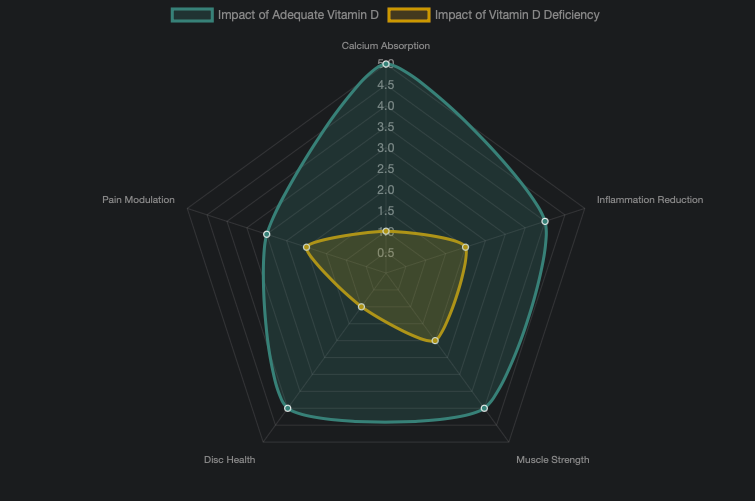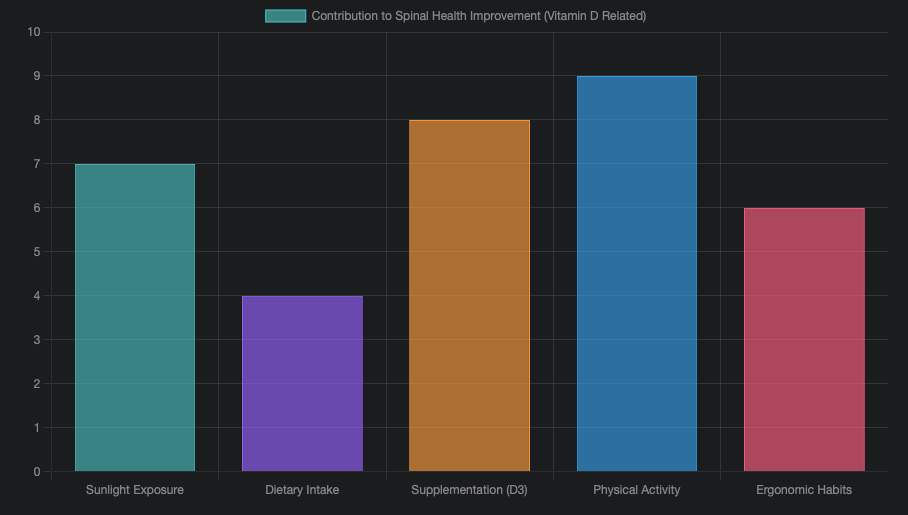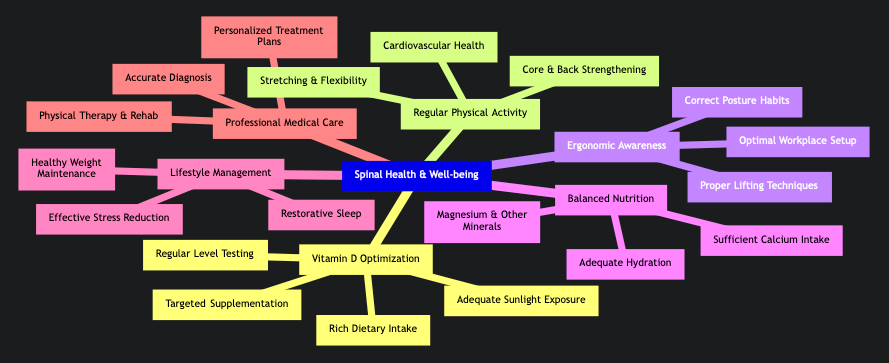The connection between Vitamin D levels, chronic back pain, and disc degeneration.
77+ Sources
- Key Insights into Vitamin D and Spinal Health
- The Intricate Link Between Vitamin D and Your Spine
- Unpacking the Evidence: Associations and Nuances
- Visualizing Vitamin D’s Impact
- Optimizing Your Vitamin D Levels for Spinal Well-being
- A Holistic Perspective on Spinal Health
- The Deeper Connection: Vitamin D and Spinal Degeneration
- Frequently Asked Questions
- Conclusion
- Recommended Further Exploration
- Referenced Search Results
Key Insights into Vitamin D and Spinal Health
- Fundamental Role: Vitamin D is critical for bone mineralization, calcium absorption, and maintaining spinal structural integrity.
- Anti-Inflammatory Power: It possesses significant anti-inflammatory properties, mitigating inflammation in spinal tissues and intervertebral discs.
- Holistic Approach: While vital, addressing Vitamin D deficiency is part of a broader strategy for back health, encompassing physical activity, diet, and professional medical guidance.
The “sunshine vitamin,” Vitamin D, is far more than just a bone-strengthening agent; it plays a multifaceted and crucial role in maintaining overall spinal health and alleviating chronic back pain. Its impact extends from bone density and muscle function to modulating inflammatory responses within the delicate structures of the spine. Understanding this intricate relationship is key to addressing persistent back issues, particularly for those at risk of deficiency.
The Intricate Link Between Vitamin D and Your Spine
Research consistently highlights the profound connection between adequate Vitamin D levels and a healthy spine. Its influence is not limited to a single mechanism but encompasses several biological pathways that collectively support spinal integrity and function.
Bone and Mineral Homeostasis: The Foundation of Spinal Strength
Calcium Absorption and Bone Mineralization
Vitamin D is indispensable for the intestinal absorption of calcium, a cornerstone mineral for bone health. Without sufficient Vitamin D, the body’s ability to absorb dietary calcium is severely compromised, leading to a cascade of issues. This deficiency can result in inadequate bone mineralization, contributing to conditions like osteomalacia in adults and increasing the risk of osteoporosis. A strong, healthy spine relies on robust vertebral bodies, and compromised bone density directly weakens this crucial support structure, making it more susceptible to damage and pain.

Illustration depicting the intricate structure of healthy bone, emphasizing the importance of bone density.
Impact on Vertebral Discs and Degeneration
Beyond bone, Vitamin D plays a direct role in maintaining the health and resilience of intervertebral discs. These spongy cushions between vertebrae absorb shock and allow spinal flexibility. Studies indicate that Vitamin D contributes to disc health by influencing cellular processes and potentially delaying degenerative changes. Low Vitamin D levels have been associated with accelerated disc degeneration and increased susceptibility to damage, leading to chronic lumbar pain.
Anti-Inflammatory Prowess: Calming Spinal Tissues
One of Vitamin D’s most significant contributions to spinal health is its potent anti-inflammatory properties. Chronic inflammation is a key driver of pain and degeneration in spinal tissues, including the intervertebral discs. Vitamin D has been shown to modulate inflammatory pathways, reducing the levels of pro-inflammatory markers and oxidative stress. This action helps protect disc cells from damage, delays cell aging and apoptosis (cell death), and consequently, can mitigate chronic back pain.
Muscle Function and Support: Stabilizing the Spine
The spine is supported by a complex network of muscles. Vitamin D is essential for proper muscle function and strength. A deficiency can lead to muscle weakness, aches, and cramps, particularly in the muscles that support the spine. Weakness in these core and back muscles can destabilize the spinal column, increasing mechanical stress on discs and vertebrae, thereby exacerbating back pain and contributing to postural issues. Correcting Vitamin D deficiency can improve muscle strength and reduce musculoskeletal pain, offering better support for the spine.
Unpacking the Evidence: Associations and Nuances
While a significant body of research supports the link between Vitamin D deficiency and spinal issues, it’s important to understand the nuances of this relationship.
The Consensus: Strong Associations
Multiple studies confirm that individuals with low Vitamin D levels frequently experience higher rates of chronic musculoskeletal pain, including back pain. Observational studies have consistently shown associations between lower 25(OH)D levels (the circulating form of Vitamin D) and more pronounced lumbar disc degeneration. Furthermore, the role of Vitamin D receptors (VDR) and genetic polymorphisms in disc disease susceptibility has been highlighted, reinforcing Vitamin D’s mechanistic involvement.
When Evidence is Mixed: Causation and Relief
It’s crucial to distinguish between association and direct causation. While many studies find a strong correlation, some larger observational datasets and reviews note inconsistent links between Vitamin D status and non-specific low back pain in the general population. Clinical trials on the effect of Vitamin D supplementation on back pain also show varying results: some report significant improvement, especially in severely deficient individuals, while others find limited or no benefit when baseline deficiency is mild or absent, or when dosing is infrequent.
The notion that “many people feel better within days” of correcting a deficiency is often an oversimplification. While rapid relief can occur, especially if pain is directly linked to muscle weakness or severe osteomalacia, it typically takes weeks or even months to normalize serum Vitamin D levels and for systemic improvements to manifest.
Visualizing Vitamin D’s Impact
To further illustrate the multifaceted influence of Vitamin D on spinal health, let’s consider some opinionated analyses on its perceived impact across different dimensions. These charts represent qualitative assessments based on the synthesis of available research and common clinical observations.

This radar chart illustrates the perceived impact of both adequate Vitamin D levels and Vitamin D deficiency across key aspects of spinal health, rated on a scale of 0 to 5.

This bar chart compares the relative contribution of various factors to overall spinal health improvement, including Vitamin D related strategies and broader lifestyle elements, on a scale of 0 to 10.
Optimizing Your Vitamin D Levels for Spinal Well-being
Addressing Vitamin D deficiency is a proactive step toward better spinal health. Several strategies can help ensure adequate levels:
Embracing the “Sunshine Vitamin”
Safe Sunlight Exposure
The body naturally synthesizes Vitamin D when skin is exposed to sunlight. Approximately 15-30 minutes of daily sun exposure, particularly during peak hours (10 a.m. to 4 p.m.), can significantly contribute to Vitamin D production. However, balance is key; while beneficial, dermatological guidance cautions against excessive, intentional UV exposure due to skin cancer risks. Factors like skin tone, geographical location, and season influence the amount of Vitamin D synthesized.

A person applying sunscreen outdoors, highlighting the importance of balanced sun exposure for Vitamin D synthesis and skin protection.
Dietary Sources: Nourishing Your Spine from Within
While sunlight is a primary source, incorporating Vitamin D-rich foods into your diet can help maintain healthy levels. Fatty fish are particularly good sources, but other options are available.

An array of Vitamin D-rich foods, including fatty fish, mushrooms, and fortified dairy products.
| Food Source | Typical Vitamin D Content (per serving) | Notes |
|---|---|---|
| Fatty Fish (e.g., Salmon, Mackerel, Trout, Tuna) | 400-1000+ IU | Excellent natural source; wild-caught often higher. |
| Cod Liver Oil | 400-1000+ IU (per teaspoon) | Highly concentrated source; also rich in Omega-3s. |
| Egg Yolks | 40-50 IU (per large egg) | Contains small amounts; free-range hens may have higher levels. |
| Mushrooms (UV-exposed) | 100-400+ IU (per cup) | Can produce Vitamin D2 when exposed to UV light. |
| Fortified Milk (Dairy/Plant-based) | 100-120 IU (per cup) | Commonly fortified with Vitamin D3. |
| Fortified Cereals/Orange Juice | 40-100 IU (per serving) | Check labels, amounts vary significantly. |
A table outlining common dietary sources of Vitamin D and their approximate content.
Supplementation: A Targeted Approach
When dietary intake and sun exposure are insufficient, Vitamin D3 (cholecalciferol) supplements are often recommended. It is paramount to consult a healthcare provider before initiating supplementation to determine the appropriate dosage, as excessive intake can lead to toxicity (hypercalcemia).

A bottle of Vitamin D3 supplements and individual pills, representing the common form of supplementation.
Testing and Dosage
If you experience chronic back pain, especially with risk factors for deficiency (e.g., limited sun exposure, darker skin, older age, obesity), a 25-hydroxyvitamin D blood test is advisable. Many clinicians aim for serum 25(OH)D levels around 20–30 ng/mL (50–75 nmol/L) or higher. Common maintenance doses range from 1,000-4,000 IU/day for adults, but loading doses may be prescribed for significant deficiencies. It’s crucial not to exceed 4,000 IU/day chronically without medical supervision.
A Holistic Perspective on Spinal Health
While Vitamin D is a vital piece of the puzzle, optimal spinal health is achieved through a multi-pronged approach. This mindmap illustrates the interconnectedness of various factors contributing to a healthy back, emphasizing that Vitamin D is one crucial component within a larger framework.
mindmap
root[“Spinal Health & Well-being”]
Vitamin D[“Vitamin D Optimization”]
Sunlight[“Adequate Sunlight Exposure”]
Dietary_Sources[“Rich Dietary Intake”]
Supplementation[“Targeted Supplementation”]
Testing[“Regular Level Testing”]
Physical_Activity[“Regular Physical Activity”]
Strength_Training[“Core & Back Strengthening”]
Flexibility[“Stretching & Flexibility”]
Aerobic_Exercise[“Cardiovascular Health”]
Ergonomics[“Ergonomic Awareness”]
Workplace_Setup[“Optimal Workplace Setup”]
Posture[“Correct Posture Habits”]
Lifting_Techniques[“Proper Lifting Techniques”]
Nutrition[“Balanced Nutrition”]
Calcium[“Sufficient Calcium Intake”]
Magnesium[“Magnesium & Other Minerals”]
Hydration[“Adequate Hydration”]
Lifestyle_Factors[“Lifestyle Management”]
Weight_Management[“Healthy Weight Maintenance”]
Stress_Reduction[“Effective Stress Reduction”]
Quality_Sleep[“Restorative Sleep”]
Professional_Care[“Professional Medical Care”]
Diagnosis[“Accurate Diagnosis”]
Treatment_Plans[“Personalized Treatment Plans”]
Rehabilitation[“Physical Therapy & Rehab”]

A mindmap illustrating the various interconnected factors that contribute to overall spinal health, with Vitamin D optimization as a key component.
Beyond Vitamin D: Complementary Strategies
Even with optimized Vitamin D levels, a comprehensive approach to back pain is essential. This includes:
- Regular Physical Activity: Engaging in exercises that strengthen core and back muscles, improve flexibility, and promote overall fitness.
- Ergonomic Adjustments: Ensuring proper posture and ergonomic setups at work and home to minimize spinal strain.
- Weight Management: Maintaining a healthy weight to reduce excess load on the spine.
- Stress Reduction: Chronic stress can exacerbate pain, so incorporating stress-reducing techniques is beneficial.
- Adequate Sleep: Ensuring restorative sleep allows spinal tissues to repair and regenerate.
The Deeper Connection: Vitamin D and Spinal Degeneration
The role of Vitamin D in degenerative disc disease (DDD) is an area of ongoing research, but accumulating evidence points to its significant impact. Here’s a relevant video that delves into degenerative disc disease, providing context to the importance of factors like Vitamin D in its management and prevention.
This video explains degenerative disc disease (DDD) and offers exercises to manage pain, providing valuable context for understanding spinal health challenges that Vitamin D can influence.
The video discusses the mechanics of DDD and potential exercise-based solutions. Understanding how discs naturally age and lose hydration, as explained in such resources, underscores why nutrients like Vitamin D, which can reduce inflammation and support cellular health, are vital. By mitigating oxidative stress and inflammation, Vitamin D may help slow the progression of disc degeneration, complementing the exercise and ergonomic strategies often recommended for DDD.
Frequently Asked Questions
Why is Vitamin D called the “sunshine vitamin”?
It is called the “sunshine vitamin” because the human body produces Vitamin D when the skin is directly exposed to sunlight.
Can Vitamin D deficiency cause acute back pain, or is it usually chronic?
Vitamin D deficiency is more commonly associated with chronic, persistent musculoskeletal pain, including chronic low back pain, rather than acute, sudden pain. However, severe deficiency leading to conditions like osteomalacia can cause significant bone pain that might feel acute in intensity.
How quickly can Vitamin D supplementation alleviate back pain?
The timeline for pain relief from Vitamin D supplementation varies greatly among individuals. While some may report improvements within weeks, especially if the deficiency is severe and directly contributing to muscle or bone pain, it often takes several weeks to months for serum levels to normalize and for noticeable symptomatic improvement to occur.
Are there any risks associated with taking too much Vitamin D?
Yes, excessive intake of Vitamin D can lead to Vitamin D toxicity, also known as hypervitaminosis D. This condition can cause hypercalcemia (high calcium levels in the blood), leading to symptoms such as nausea, vomiting, weakness, frequent urination, and in severe cases, kidney problems and bone pain. It is crucial to consult a healthcare professional to determine the appropriate dosage and to monitor Vitamin D levels.
What is the optimal Vitamin D level for spinal health?
While definitions vary slightly, many experts consider a serum 25(OH)D level of 20 ng/mL (50 nmol/L) as sufficient for most people. However, for bone health and potentially for reducing musculoskeletal pain, many clinicians aim for levels between 30 ng/mL (75 nmol/L) and 50 ng/mL (125 nmol/L). It’s best to discuss target levels with your healthcare provider.
Conclusion
The evidence overwhelmingly supports the critical role of Vitamin D in maintaining spinal health and mitigating chronic back pain and disc degeneration. Its influence spans calcium regulation, bone mineralization, inflammation reduction, and muscle function. While a robust link exists, particularly in deficient individuals, it is crucial to approach back pain management holistically, incorporating other lifestyle factors alongside Vitamin D optimization. Consulting a healthcare professional for diagnosis, testing, and personalized guidance remains the best course of action for anyone experiencing persistent back issues.
Recommended Further Exploration
- Comprehensive strategies for chronic low back pain management
- Role of core strength in spinal stability and back pain
- Impact of inflammation on intervertebral disc degeneration
- Latest research on vitamin d and musculoskeletal disorders
Referenced Search Results
sciencedirect.com
Vitamin D/VDR in the pathogenesis of intervertebral disc… – ScienceDirect
nature.com
Vitamin D Receptor gene polymorphisms and plasma… – Nature
roachchiropractic.com
Vitamin D and the Spine – Roach Chiropractic
sandiegospinesurgeon.com
How Vitamin D Affects Degenerative Spine Disease – San Diego Spine Surgeon
compspinecare.com
Vitamin D and Your Spine – Comprehensive Spine Care
adrspine.com
Top Supplements for Spinal Health – ADR Spine
spinehealth.org
Nutrition and the Spine – Spine-health.org
docwirenews.com
sutterhealth.org
Can Vitamin D help reduce back pain? – Sutter Health
pubmed.ncbi.nlm.nih.gov
Downregulation and Hypermethylation of Vitamin D Receptor in Lumbar …
pmc.ncbi.nlm.nih.gov
A Review of Vitamin D in Spinal Surgery: Deficiency Screening …
medcentral.com
mdpi.com
pmc.ncbi.nlm.nih.gov
Vitamin D retards intervertebral disc degeneration through …
supplementsreport.com
Vitamin D deficiency: The hidden culprit behind America’s osteoporosis epidemic
pubmed.ncbi.nlm.nih.gov
Vitamin D deficiency and chronic low back pain in Saudi Arabia – PubMed
pubmed.ncbi.nlm.nih.gov
Vitamin D receptor gene polymorphisms and risk of intervertebral …
mdpi.com
Downregulation and Hypermethylation of Vitamin D …
womenshealth.gov
ncbi.nlm.nih.gov
Vitamin D, Calcium, and Dairy Intakes and Stress Fractures Among Female Adolescents
supplementsreport.com
The silent epidemic: How VITAMIN B12 deficiency is often misdiagnosed
pmc.ncbi.nlm.nih.gov
Vitamin D deficiency may have role in chronic low back pain – PMC
mdpi.com
journals.lww.com
The effectiveness of vitamin D 3 supplementation in improving …
journals.sagepub.com
The role of vitamin D in maintaining bone health in older people
pmc.ncbi.nlm.nih.gov
ajcn.nutrition.org
Vitamin D and bone health in the elderly
sciencedirect.com
Vitamin D and pediatric bone health – ScienceDirect.com
trialsjournal.biomedcentral.com
Role of vitamin D3 in Treatment of Lumbar Disc Herniation—Pain …
thepermanentejournal.org
news-medical.net
Could vitamin D levels be associated with lower back pain?
journals.lww.com
Vitamin D Deficiency and Chronic Low Back Pain in Saudi…
pmc.ncbi.nlm.nih.gov
Vitamin D and Calcium in Osteoporosis, and the Role of Bone …
degruyterbrill.com
medicalnewstoday.com
Can vitamin D supplements help alleviate lower back pain?
ncbi.nlm.nih.gov
Influence of vitamin D levels on bone mineral density and osteoporosis
orthoinfo.aaos.org
Vitamin D for Good Bone Health – OrthoInfo – AAOS
health.com
These 14 Symptoms Could Be a Sign of Vitamin D Deficiency
journals.lww.com
Vitamin D Deficiency and Chronic Low Back Pain in Saudi… : Spine
news.harvard.edu
You likely don’t need vitamin D pills for strong bones – Harvard Gazette
bonehealthandosteoporosis.org
[PDF] Vitamin D and Bone Health
my.clevelandclinic.org
Vitamin D Deficiency: Causes, Symptoms & Treatment
osteoporosis.foundation
Vitamin D – International Osteoporosis Foundation
houstonmethodist.org
How Vitamin D Deficiency Affects the Body | Houston Methodist
healthline.com
Vitamin D Deficiency: Symptoms, Treatments, and Causes
sciencedirect.com
Potential causal association between serum vitamin D …
pmc.ncbi.nlm.nih.gov
onlinelibrary.wiley.com
Vitamin D delays intervertebral disc degeneration and …
pmc.ncbi.nlm.nih.gov
A Survey of Vitamin D Status in Patients with Degenerative Diseases …
pubmed.ncbi.nlm.nih.gov
The effectiveness of vitamin D3 supplementation in improving …
longevity.stanford.edu
Vitamin D: Benefits, Sources, Deficiency | Supplements
pmc.ncbi.nlm.nih.gov
Effect of Vitamin D on Bone Regeneration: A Review
practo.com
Vitamin D deficiency – I have had a upper back pain for last | Practo Consult
pmc.ncbi.nlm.nih.gov
Vitamin D and Bone Health; Potential Mechanisms – PMC
drmimi.com
The Impact of Vitamin D Status on Lumbar Spinal Stenosis
dergipark.org.tr
aafp.org
Recognition and Management of Vitamin D Deficiency | AAFP
academic.oup.com
Effects of Supplemental Vitamin D on Bone Health Outcomes in …
sciencedirect.com
Evaluation of vitamin D levels in patients with chronic low back-leg pain – ScienceDirect
crimsonpublishers.com
nhs.uk
[Vitamin D
- NHS](https://www.nhs.uk/conditions/vitamins-and-minerals/vitamin-d/)
sciencedirect.com
The effect of vitamin D on bone and osteoporosis
sciencedirect.com
pubmed.ncbi.nlm.nih.gov
Vitamin D receptor gene polymorphism influence on lumbar …
healthcentral.com
quora.com
Can a backache be a sign of vitamin D deficiency? – Quora
conspineandsport.com
The Link Between Vitamin D and Spinal Health
contemporaryobgyn.net
Vitamin D deficiency leads to lower back pain
jamanetwork.com
Effect of High-Dose Vitamin D Supplementation on Volumetric Bone …
healthline.com
Healthline Nutrition — Vitamins & Supplements
webmd.com
Vitamin D Deficiency: Causes, Symptoms & Health Risks
ncbi.nlm.nih.gov
A Survey of Vitamin D Status in Patients with Degenerative Diseases …
conlinhealthcare.com
8 Signs and Symptoms of Vitamin D Deficiency — Conlin Health Care, Inc.
reddit.com
r/backpain on Reddit: is my back pain caused by a vitamin d3 deficiency?
supplementsreport.com
5 Types of people who should supplement with Vitamin D
ncbi.nlm.nih.gov
Vitamin D retards intervertebral disc degeneration through …
journals.lww.com
Does vitamin D status influence lumbar disc degeneration …
Last updated September 8, 2025

